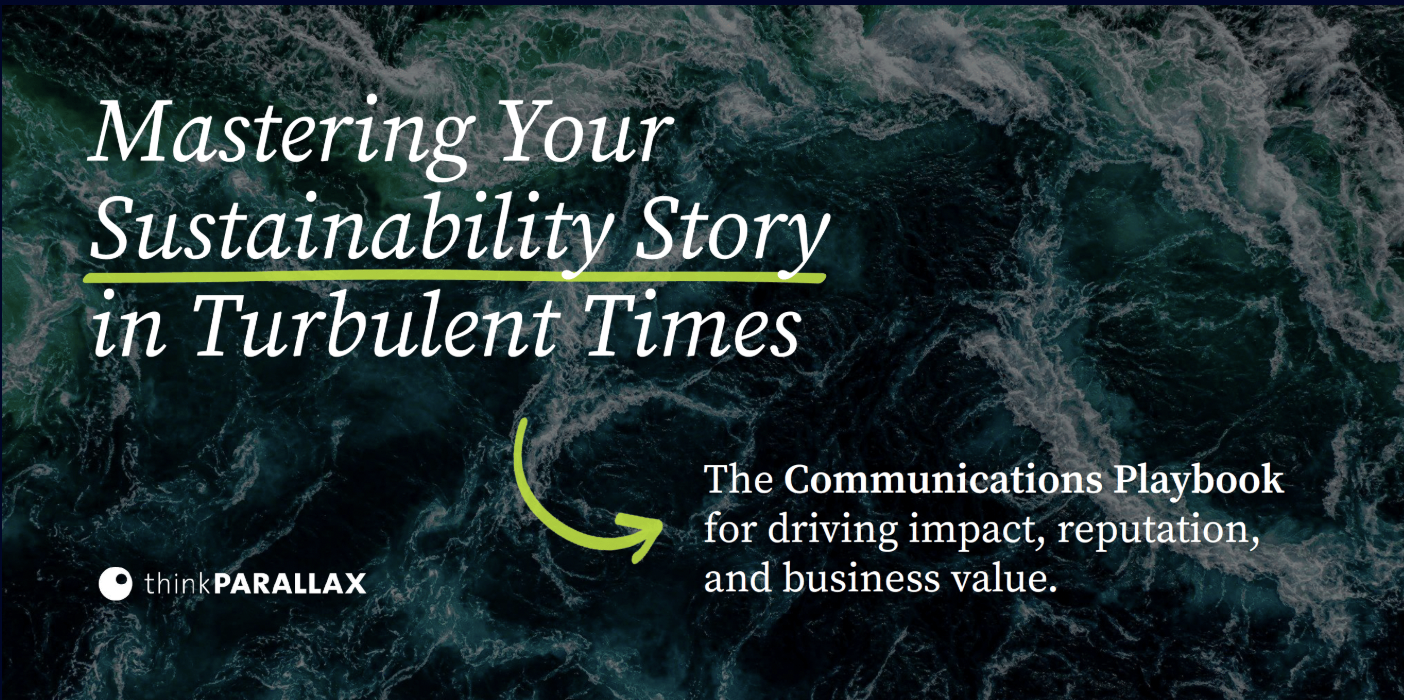Since the European Sustainability Reporting Standards (ESRS) rollout was paused in early 2025, the thinkPARALLAX team has fielded a steady stream of questions from clients about the future of the standards. The wait is partly over: in July, the European Financial Reporting Advisory Group (EFRAG), the body responsible for drafting the European Sustainability Reporting Standards, released July 2025 exposure drafts. The latest drafts aim to improve the understandability, clarity, and accessibility of the ESRS standards.
Below, you’ll find the latest adoption timeline for these draft standards, answers to the most common questions we’ve received on ESRS interpretation, and our guidance on what companies should consider as they plan for implementation in the months or years ahead, depending on their reporting deadline.
Background
EFRAG’s review of the ESRS is part of the European Commission’s omnibus simplification package. EFRAG’s goal is to simplify reporting under the Corporate Sustainability Reporting Directive (CSRD) while maintaining alignment with the European Green Deal, which seeks to transition the European Union (EU) to a decarbonized economy by 2050 and foster sustainable development across European businesses. As part of this process, EFRAG engaged with stakeholders to make the standards more manageable.
Our Take on Commonly Asked Questions
The latest publication is referred to as “exposure drafts.” Can we expect more changes? Should my company apply the 2023 standards or wait and see before aligning to the latest draft? When will they be final?
Yes, these are still draft standards. However, when the 2023 standards (the current published version) was in development, many companies began preparing to adopt the drafts while keeping flexibility for final amendments. We recommend the same approach here.
For companies in waves 2, 3, and 4, the 2023 standards will no longer apply once the updated standards are adopted. The drafts clearly identify areas where stakeholder feedback is sought, and those are the sections most likely to see changes. For sections without active debate, we can expect the content to remain largely intact in the final standards.
Below is a detailed timeline on the journey the standards will take in the months ahead.
-
July 31, 2025: Exposure drafts of the revised ESRS were released for a 60-day public consultation.
-
September 29, 2025: The public consultation on the exposure drafts closes.
-
End of November 2025: EFRAG will provide its final recommendations for the standards, taking into account the feedback from the public consultation, to the European Commission.
-
December 2026 - Jan/Feb/March 2026: We can anticipate the final ESRS to be confirmed and adopted in early to mid-2026. After receiving EFRAG’s technical advice, the European Commission will adopt a delegated act to finalize the amended ESRS. This delegated act will then be sent to the European Parliament and the Council of the EU for a scrutiny period of two to four months. If no objections are raised, the amended standards will be published in the Official Journal of the EU and become legally binding.
-
Once the delegated act is finalized and published, the standards become effective immediately. Member states will focus on aligning their existing legal frameworks and ensuring enforcement.
So, short answer? Prepare now based on the drafts, but build in room for adjustments once the final standards are confirmed.
Timeline for Reporting:
-
Wave 1: Companies that reported in 2025 will publish their second report in 2026 following the 2023 standards, with some “quick-fix amendments” that came into effect in 2025.
-
Waves 2 and beyond: The reporting timeline has been delayed by two years, with first reports now due in 2028 (covering FY 2027). These companies can expect to adopt the updated ESRS, once finalized.
I have read that there is a 57 percent reduction in datapoints in the standards. What are the main changes in the latest draft?
You’d probably stop reading this if I described every change in detail, but below are some observations and examples to help illustrate the proposed changes.
Many are edits and clarifications to the text, such as removing repetition and redundancy, the level of granularity required, and removal of all voluntary disclosures. These edits make up a significant portion of the updates, though this article does not aim to provide an exhaustive list.
-
Notable structural updates include: Allowing a company to include an executive summary in the sustainability statement.
-
Permitting a company to include information on non-material topics, disclosed in the appendix, where, for example, the information would be relevant to a rating agency.
-
Introducing new relief mechanisms, such as exemptions where reporting would cause undue cost or effort.
A few specific examples of proposed changes are outlined below:
-
E1-1 — Climate Change Transition plan for climate change mitigation
The requirement for a company to disclose its transition plan for climate change mitigation has been removed. But note it isn’t actually gone, rather EFRAG acknowledged that the disclosure requirement was repeated in the 2023 standards. The draft clarifies that companies do not need to provide the full transition plan (TP) itself, but should include information about it within their reporting.
-
S1-8 — Own Workforce Diversity metrics
Looking at S1 “Own Workforce,” S1-9 diversity metrics, there is a clear slimming down of disclosure requirements. Under the 2023 standards, a company would disclose the gender distribution at top management as well as the age distribution among its employees. Under the latest draft, only gender distribution in number (headcount) and percentage at top management level is required. Age distribution of the overall workforce has been removed.
-
E1-7 — Climate Change Energy consumption and mix
And a final example, under E1-5, companies were previously required to report renewable energy consumption and mix by type (renewable, purchased or acquired, self-generated non fuel). Such disaggregation will no longer be required due to complexity and lack of data available, and companies will now report total energy consumption from renewable sources only.
All this is to say that while the standards have indeed changed, there is still plenty of data to gather, validate, and report under the new draft standards. Assurance is still mandatory. It is important to look beyond the headlines — 57% reduction in datapoints will not equate to a 57% reduction in work, however, it should go some way toward lightening the interpretation quandary and reporting burden for companies.
We conducted a double materiality assessment (DMA) following the guidance in the 2023 standards. How can we leverage the new standards to refine our results?
The double materiality assessment retains its pivotal role in the preparation of sustainability statements under ESRS. Materiality continues to be the starting point to determine information to be disclosed in the sustainability statement. ESRS is a principle-based system, and given the variance across sectors and companies, prescriptive thresholds have not been provided, despite some stakeholder requests.
The updated standards aim to streamline the double materiality assessment (DMA), reducing overall complexity of the process. Here are some adjustments to the principles and process of a double materiality assessment:
-
Similar to the International Sustainability Standards Board (ISSB) and other frameworks, an emphasis has been placed on the ESRS being a “fair presentation” framework. As in, it should reflect what’s actually going on in your business and not be a check-the-box exercise.
-
Across all standards, the term “material matter” is now replaced by “topic to be reported in relation to material IROs,” to signify that a topic is not material per se, but its IROs determine that a given topic is to be reported.
-
The specific IRO determines what topic or portion of the standards needs to be reported. A material IRO does not trigger materiality of the entire standard. For example, a construction company identifies that air emissions from one production facility pose a material risk due to local regulatory non-compliance and community concerns. Since only air emissions are material, only this sub-topic will be disclosed and unrelated sub-topics like water or soil pollution can be excluded in relation to this IRO. All this is to say: focus on the IRO. Once you have an IRO, link it to the appropriate topic within the standard and report accordingly.
-
-
In executing a DMA, “practical considerations” should be taken into account to reduce complexity, including unnecessary scoring of topics.
-
EFRAG has clarified that the DMA should start from the analysis of the business model and conclusions should be supported with reasonable and proportionate evidence.
-
Taking a top-down view of a company’s business model helps identify relevant topics and justify their materiality with reasonable, proportionate evidence. For instance, if peers in a sector—such as clothing manufacturers—consider “working conditions in the value chain” to be material, a company can reasonably adopt the same view without a lengthy scoring process.
-
The treatment of remediation, mitigation, and prevention measures has been clarified when assessing actual and potential negative impacts. Actual impacts are assessed for materiality before the remediation actions in the reporting period when they occur, while in future periods they are not reported if fully remediated. If, for example, a factory’s past chemical spill is still causing harm, the company must report the spill as a material impact even while disclosing a new remediation project to clean up the river. For potential impacts, when the undertaking must maintain significant ongoing actions to contain severity and/or likelihood below the materiality level, the impact is assessed before the actions are reported. The company would report on the steps it is taking to prevent a spill such as new safety protocols, even if it has not yet occurred.
-
Final recommendations
The consultation period is now open, the outcome of which will shape reporting requirements. It is up to users and preparers to submit your views on those changes. Don’t miss the opportunity to contribute to the conversation.
Focus on the big picture and don’t get too distracted. Ask yourself:
-
Is my organization ready for ESRS reporting? The clock has ticked on since wave 2, 3, and 4 organizations were given an extension to their reporting deadline. Wave 2 organizations will be reporting publicly in early 2028, which means data will need to be collected and validated during 2027. If you have never reported before, conducting a dry run in 2027 on 2026 data is advisable. 2026 starts in 4 months!
-
Do you know what IROs are material? Are you managing those IROs and are you ready to report on them?
-
It may be time to plan a refresh of your DMA once the final standards are released.
-
DMAs don’t need to be significant undertakings — we offer a 6-week refresh that can help companies get laser-focused on priorities.
-
What datapoints are applicable under the new proposed draft based on your identified material IROs? Which will become voluntary (and thereby, subject to further internal discussion on whether they should be reported publicly)?
You wouldn’t stop managing something that is material to your business while waiting for the standards. If you can sit back and wait for regulations, then ask yourself if this topic is truly material to your financial success and sustainability performance. Ensure that your sustainability actions are aligned to your key IROs. Reporting is where you communicate how you are responding to impacts and mitigating against risks and seizing the opportunities.
Want to talk through your ESRS strategy? We're here to help. Reach out anytime.






